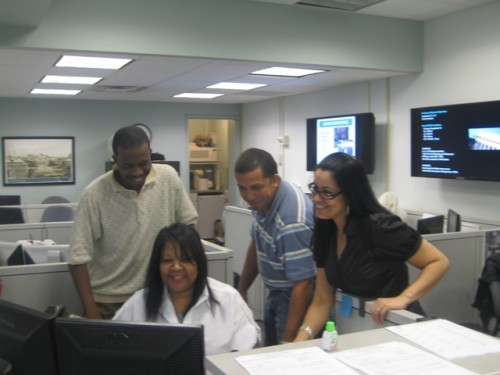Two Years After Launch, Facilities Services Center Keeps on Growing
Service Coordinators and Technological Advances Contribute to Success

Since its official launch in January 2006, the Facilities Services Center has been integral in its support of Facilities' many operations. Similar to New York City's 311 phone line, the Services Center manages an array of requests for services from Campus and Residential Operations and information on construction activities. Over the last year, the Center has successfully processed more than 50,000 service requests and answered more than 72,600 customer calls on its 4-2222 line.
At the forefront of the Center's impressive performance is the replacement of a formerly area-focused structure - in which client contact with Facilities was segmented both physically and operationally into four campus locales - with a unified establishment that consolidated all groups as a single point of contact. The team now resides in B-230 East Campus, which permits an easy collaboration with Facilities' central shops, and custodial and capital project management teams.
The Services Center's transition to its new service model came about naturally, mainly due to the enhanced fl ow of communication among team members. Fred Small, who leads the Services Center, explains, "Our main goal is to support the University-wide effort to improve client service. Since we've consolidated, our operations have been more effi cient. We now have consistent standards for service delivery. We're more productive because we're working closely together."
Juliette Hutchinson, a services coordinator who has worked with the University for 12 years, believes that the Center's core function has remained the same. "We still get every type of call - windows that can't open, rooms that are too hot or cold, and toilets that need repairs. Having everyone under one roof makes it easier. We can dispatch the workload on a timely basis and communicate with each other about the calls we get, without duplicating efforts."
In addition to the Services Center's centralized location, new technologies were also incorporated to quickly facilitate services and give ease to daily operations. There is now a phone system in place that reports the phone activity and benchmarks the amount of calls received per day and when calls are lost. The Services Center also uses a Web site to assist with each call. The site serves as a major source of current information on call lists, policies, procedures, and contact information. Similarly, three new flat screen televisions now hang from the Center's walls and are used to update, post, and cycle general information on Facilities, key events on campus, shut downs, and disruptions.
"Each morning, we make sure to keep everyone notifi ed of everything that's going on. The Web site and screens are helpful in fielding calls, since information is quickly available," Wanda Roman, Services Center Supervisor, says.
In addition to new technology, extensive training has helped to improve the Services Center. Before any new staff member can take phone requests, they must be trained for the duration of at least a month. "You have to be fast and there can be tough clients. There's also a lot information to retain," Wanda says. "That's why I know that we have extraordinary individuals, some of whom have been with the University for years. They care deeply about making Columbia work, and because they now all sit in the same room, we can all easily work together to best assist with everyone's needs."
These needs not only consist of expediting services via phone, but also managing requests that come from faxes and the Facilities' Web site. In addition, the team handles the dispatch of urgent calls, extensive data entry, and billing inquiries. Recently, the Center added an additional function - fielding construction-related questions. Services Coordinators are briefed on Facilities' major construction activities and perform as accessible gateways for construction questions and concerns.
With additional responsibilities, including the increase in the Center's hours to 24 hours a day, 7 days a week, departmental staffing for the weekends and nights has increased. The team now works in three shifts - an increase from two - and is comprised of 11 hourly services coordinators. A second assistant supervisor will soon be brought onto the team to support the coordinators on the off-hours.
As the Services Center continues in its success, Fred marvels at his team's performance and growth. "We have an extremely busy and hardworking group. In my own opinion, they are the hardest working university contact center with the heaviest responsibility. Each person must exercise good judgment and is able to handle multiple responsibilities. I'm proud of our group and know that we will continue to do well."